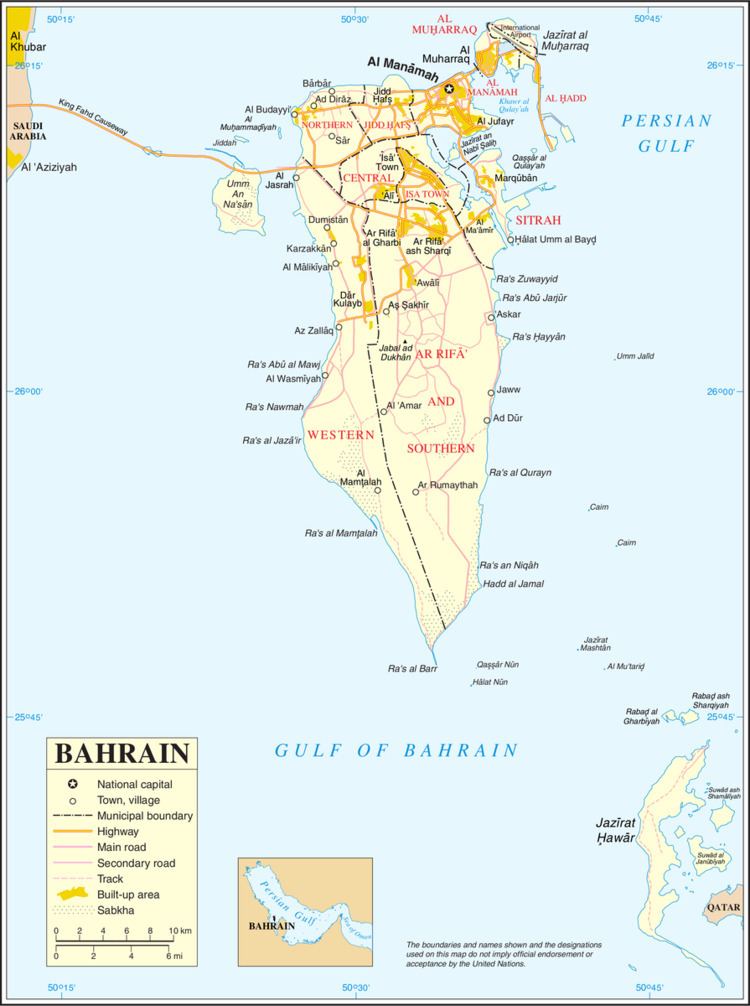 | ||
Transport in Bahrain encompasses road transportation by car, air transportation and shipping. It has been announced that a monorail network will be constructed. Bahrain has one of the lowest gasoline prices in the world, at $0.78 per gallon ($0.21 per liter).
Contents
Road transport
The widening of roads in the old districts of Manama and the development of a national network linking the capital to other settlements commenced as early as the arrival of the first car in 1914. The continuous increase in the number of cars from 395 in 1944, to 3,379 in 1954 and to 18,372 cars in 1970 caused urban development to primarily focus on expanding the road network, widening carriageways and the establishment of more parking spaces. Many tracks previously laid in the pre-oil era (prior to the 1930s) were resurfaced and widened, turning them into 'road arteries'. Initial widening of the roads started in the Manama Souq district, widening its main roads by demolishing encroaching houses.
A series of ring roads were constructed (Isa al Kabeer avenue in the 1930s, Exhibition avenue in the 1960s and Al Fateh highway in the 1980s), to push back the coastline and extend the city area in belt-like forms. To the north, the foreshore used to be around Government Avenue in the 1920s but it shifted to a new road, King Faisal Road, in the early 1930s which became the coastal road. To the east, a bridge connected Manama to Muharraq since 1929, a new causeway was built in 1941 which replaced the old wooden bridge. Transits between the two islands peaked after the construction of the Bahrain International Airport in 1932.
To the south of Manama, roads connected groves, lagoons and marshes of Hoora, Adliya, Gudaibiya and Juffair. Villages such as Mahooz, Ghuraifa, Seqaya served as the end of these roads. To the west, a major highway was built that linked Manama to the isolated village port of Budaiya, this highway crossed through the 'green belt' villages of Sanabis, Jidhafs and Duraz. To the south, a road was built that connected Manama to Riffa. The discovery of oil accelerated the growth of the city's road network.
The four main islands and all the towns and villages are linked by well-constructed roads. There were 3,164 km (1,966 mi) of roadways in 2002, of which 2,433 km (1,512 mi) were paved. Multiple causeways stretching over 2.8 km (2 mi), connect Manama with Muharraq Island, and the Sitra Causeway joins Sitra to the main island. A four-lane highway atop a 24 km (15 mi) causeway, linking Bahrain with the Saudi Arabian mainland via the island of Umm an-Nasan was completed in December, 1986, and financed by Saudi Arabia. In 2000, there were 172,684 passenger vehicles and 41,820 commercial vehicles.
Bahrain's port of Mina Salman can accommodate 16 oceangoing vessels drawing up to 11 m (36 ft). In 2001, Bahrain had a merchant fleet of eight ships of 1,000 GRT or over, totaling 270,784 GRT. Private vehicles and taxis are the primary means of transportation in the city.
Bahrain changed from driving on the left to driving on the right in 1968.
International highways
Railways
As of 2012, there are no railways in Bahrain, but plans are developing for a railway system connecting all the countries in the Persian Gulf and for a light rail network within Bahrain. A subway system has also been proposed.
Monorail
Plans are now back on track for construction of a monorail, which would run throughout the island state. Bahrain's Cabinet initially approved the monorail plan in the noughts, though the Global Financial Crisis has delayed the project.
Airports
On a 2014 estimate, Bahrain owns two airports. Among them is Bahrain International Airport, the primary airport in the country.
Ports and harbors
As of 2008, Bahrain owns three harbors in Manama, Mina Salman and Sitrah.
